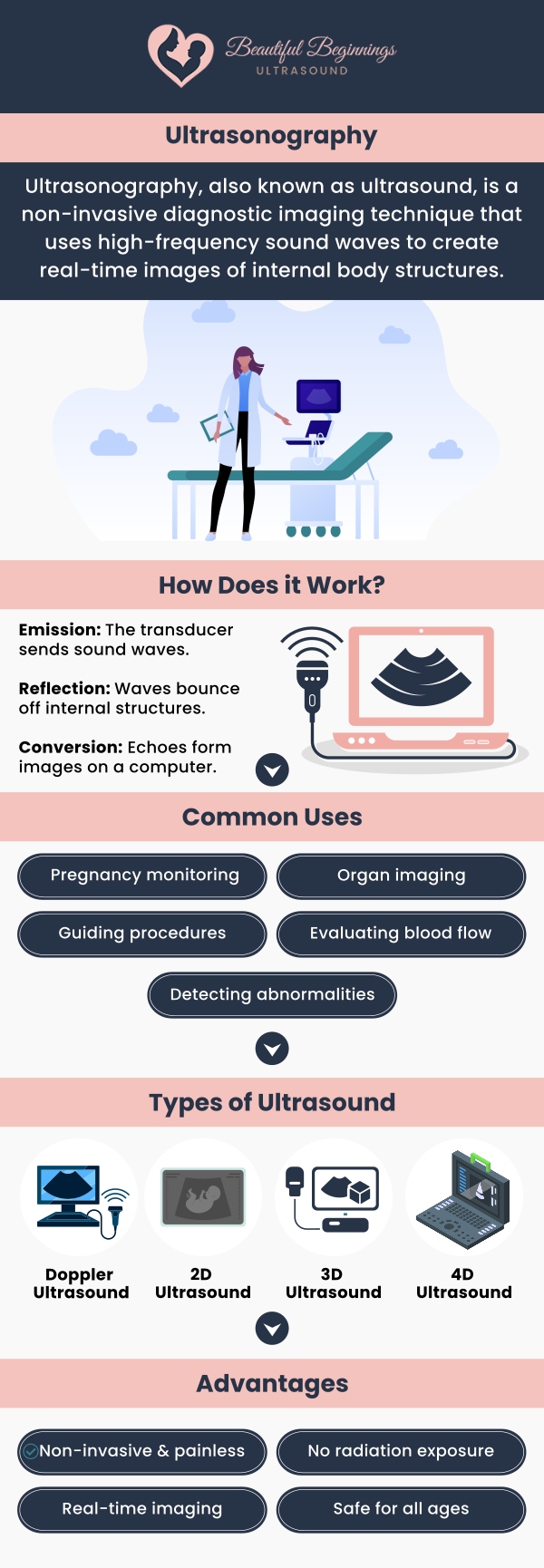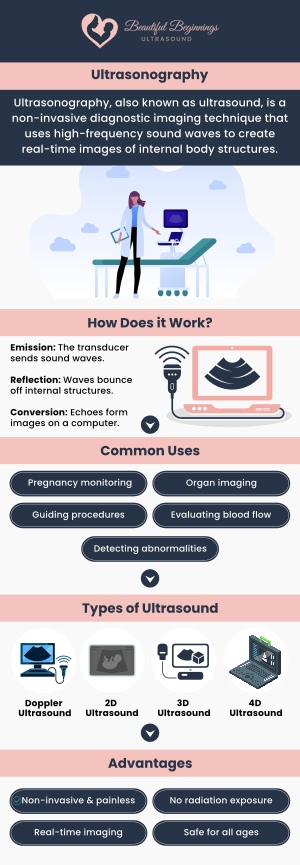What Are the Benefits of Ultrasound?
Ultrasound technology has revolutionized the field of medicine, providing a safe and non-invasive way to diagnose and treat a range of medical conditions. By using sound waves to create images of internal body structures, ultrasounds have become an essential tool for medical professionals. Visit Beautiful Beginnings Ultrasound Clinic today to get specialized and comprehensive care. For more information, contact us today or book an appointment online. We are conveniently located at 180 Ave at the Cmns Suite 9, Shrewsbury, NJ 07702.




Table of Contents:
What is an ultrasound?
How does an ultrasound work?
What are the benefits of an ultrasound?
How do I prepare for an ultrasound?
An ultrasound (also called sonography) is a non-invasive imaging test. Ultrasound images are called sonograms. An ultrasound uses high-frequency sound waves to create real-time images or videos of internal organs or other soft tissues, such as blood vessels.
Ultrasounds allow the doctor to “see” the details of the soft tissues in your body without the need for an incision. Unlike X-rays, ultrasound does not use any radiation.
Although most people associate ultrasounds with pregnancy, doctors use ultrasounds in many different situations to examine different parts of the inside of the body.
Ultrasound imaging, also called sonography, uses a small transducer (probe) to transmit sound waves into the body and record the reflected waves. Sound waves penetrate the area being examined until they encounter a boundary between tissues, such as between fluid and soft tissue or between soft tissue and bone.
Ultrasound technology works by using high-frequency sound waves to create images of internal body structures. These sound waves are emitted from a small device called a transducer, which is placed on the skin and moved over the area being examined. The sound waves bounce off the internal structures and are then picked up by the transducer, which creates an image on a computer screen. There are different types of ultrasounds, including 2D, 3D, and 4D ultrasounds. 2D ultrasounds are the most common and produce flat, two-dimensional images. 3D ultrasounds create a three-dimensional image, while 4D ultrasounds add the element of time, creating a real-time video of the internal structures. One of the most significant advantages of ultrasound technology is its safety and non-invasive nature, as it does not use harmful ionizing radiation like X-rays.
Ultrasound technology has become an essential tool in medical diagnosis, allowing medical professionals to detect and diagnose various medical conditions such as tumors, cysts, and heart abnormalities. It is also widely used in prenatal care to monitor fetal development and detect any potential abnormalities. Additionally, the real-time imaging capabilities of ultrasounds make them an invaluable tool for guiding medical procedures such as biopsies and surgeries, reducing the risk of complications.
Ultrasound technology is not only useful in medical diagnosis but also in medical treatment. It is commonly used in physical therapy to promote tissue healing and reduce pain. Additionally, ultrasound technology has been used in targeted drug delivery for treating cancer and other diseases. By using ultrasound waves to create small openings in the cell membrane, drugs can be delivered directly to the affected cells, reducing the need for systemic treatments that can have harmful side effects. Furthermore, ultrasound technology has been used in non-invasive surgical procedures, reducing the need for traditional surgery and its associated risks.
Ultrasounds are a widely used medical imaging technique that uses high-frequency sound waves to create images of the inside of the body. Ultrasounds are used for a variety of diagnostic and monitoring purposes, and they are generally considered to be safe and non-invasive. However, preparing for an ultrasound can be a bit daunting, especially if you have never had one before.
An ultrasound is a medical imaging technique that uses high-frequency sound waves to create images of the inside of the body. There are several different types of ultrasounds available, including abdominal ultrasounds, pelvic ultrasounds, and fetal ultrasounds. The purposes of ultrasounds vary depending on the type of ultrasound being performed. For example, abdominal ultrasounds may be used to diagnose liver disease or gallstones, while pelvic ultrasounds may be used to diagnose ovarian cysts or uterine fibroids. Fetal ultrasounds, on the other hand, are used to monitor the health and development of a fetus during pregnancy.
Before you have an ultrasound, your healthcare provider will provide you with specific instructions to follow. These may include dietary restrictions, such as fasting for a certain period before the ultrasound or drinking a certain amount of water before the procedure. You may also be asked to wear loose-fitting clothing or to change into a hospital gown. In some cases, you may need to refrain from taking certain medications before the ultrasound. It is important to follow these instructions carefully to ensure that the ultrasound is as accurate as possible.
During the ultrasound procedure, you will lie on a table while a technician uses a handheld device called a transducer to create images of the inside of your body. The transducer emits high-frequency sound waves that bounce off the organs and tissues in your body, creating a picture that can be viewed on a computer screen. You may be asked to change positions or hold your breath during the procedure to help the technician get a clear picture. While ultrasounds are generally considered to be painless, you may feel some discomfort if the technician needs to press down on a certain area of your body to get a better image.
We serve patients from Shrewsbury NJ, Red Bank NJ, Little Silver NJ, Eatontown NJ, Middletown NJ, Colts Neck NJ, Rumson NJ, Holmdel NJ, Long Branch NJ, West Long Branch NJ, Ocean City NJ, Oceanport NJ, and Surrounding Areas.

Check Out Our 5 Star Reviews


Additional Services You May Need
▸ 3D Ultrasound Imaging
▸ 4D Ultrasound Imaging
▸ 5D Ultrasound Imaging
▸ 3D and 4D Ultrasound
▸ Elective Ultrasound
▸ Early Gender Determination
▸ Prenatal Ultrasound
▸ Ultrasound Imaging
▸ Ultrasound Scans
▸ 12k Imaging

Additional Services You May Need
▸ 3D Ultrasound Imaging
▸ 4D Ultrasound Imaging
▸ 5D Ultrasound Imaging
▸ 3D and 4D Ultrasound
▸ Elective Ultrasound
▸ Early Gender Determination
▸ Prenatal Ultrasound
▸ Ultrasound Imaging
▸ Ultrasound Scans
▸ 12k Imaging



